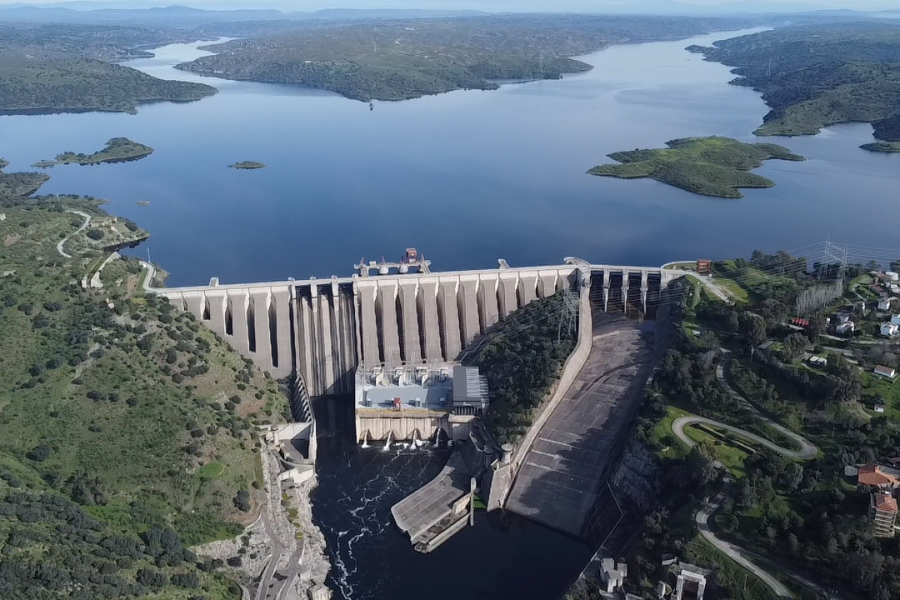Green light for Iberdrola España's new reversible hydroelectric pumping station in Alcántara, Cáceres
- Pumped-storage power plants are known as gigabatteries.
- The Ministry for Ecological Transition and the Demographic Challenge has rubberstamped the project with a favourable EIS.
- It enables reversible energy storage of 16 million kWh or the average daily consumption of 4 million people.
- The project, making use of existing facilities, will optimise management of water resources without affecting other River Tagus users.
- 44.9 million from IDEA as an "innovative project".

The project for the construction of the new Alcántara II reversible hydroelectric pumping station, located in the Cáceres municipality of Alcántara, was given a favourable Environmental Impact Statement (EIS), according to the Ministry for Ecological Transition and the Demographic Challenge’s resolution.
The project has a favourable EIS and the grid access permit and is awaiting the next administrative pre-authorisation.
This reversible pumped-storage power plant will have an installed capacity of 440 MW, allowing reversible energy storage of 16 million kWh, equal to the average daily consumption of more than 4 million people and shoring up the electricity system for up to 37 hours with the machines at full load.
This plant will be able to generate more than 1,000 additional GWh per year using the same water resources as before, preventing the emission of an estimated 355,000 tonnes of CO2 per year and contributing to the decarbonisation of the electricity system through greater integration of variable renewable energies, solar and wind, providing the electricity system with greater capacity for adaptation and response.
In its design, the plant will use the reservoirs created by the existing dams, taking into account the important environmental and heritage conditions of the surroundings. All the hydraulic circuits have been designed underground, including the plant, which is in a shaft.
The new plant will connect the lower reservoir of Cedillo and the upper reservoir of Alcántara by means of a double underground hydraulic circuit 0.9 km long and will take advantage of the up to 108 m difference in level between the reservoirs by means of two reversible turbines with a capacity of 220 MW. This "reversible" plant will improve the management and use of the existing hydroelectric system on the River Tagus, with zero impact on its other users, since in addition to not consuming the water resource from both reservoirs, as is already the case in all hydroelectric plants, it will reuse the same water in its operation.
Hydroelectric pumping: the most efficient large-scale storage system
These "reversible" or pumped-storage plants have two reservoirs that operate as a "closed loop". The upper reservoir acts as a “giant battery” storing potential energy in the form of water that is turbined to the lower reservoir to generate electricity when the system requires it. Once turbined, this water, now contained in the lower reservoir, is pumped during off-peak hours to the upper reservoir following the same route, but in the opposite direction, as a closed loop.
Today, pumped hydro is the most efficient large-scale storage system available. It allows us to store surplus energy from intermittent renewable energy sources, solar and wind, for delivery at times when it is most needed, stabilising the electricity system, as it can generate significant amounts of clean energy with a very fast response time.
The set of measures adopted to protect birdlife, terrestrial fauna, aquatic fauna and local flora stand out in the environmental aspects of the project. A set of measures with cross-border scope to improve biodiversity has also been established and recycled materials used to promote the circular economy.
Innovative storage project for the IDAE
The project was awarded 44.9 million euros last July by the Spanish Institute for Energy Diversification and Saving (IDAE) for being considered "the best proposal in terms of economic viability and technical characteristics enabling the integration of renewables", obtaining the maximum aid per installed capacity and the highest total score within the framework of the EU-funded Next Generation EU Recovery, Transformation and Resilience Plan.
